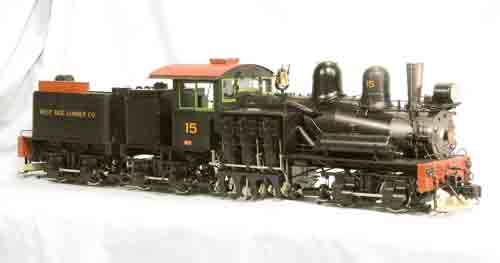1:20.3 scale, gauge 1,
three-truck Shay
Accucraft Trains
33268 Central Ave.
Union City CA 94587
Price $3,800
Web site: www.accucraft.com
All-metal model of a 60 ton, class-C Shay built by Lima Locomotive Works; electrically powered via 24V motor; directional lighting; minimum radius, 4′; working cab windows; working couplers; prototypically accurate lettering and number. Dimensions: Length, 28.5″; width: 5.5″; height 9″ (over whistle). Dimensions match published prototype drawings. Weight, 18 lbs.
Pros: Accurately dimensioned model to published drawings; high level of detail; smooth operation; strong puller
Cons: Tender over third truck loose, tends to bounce during operation; no wood-grain detail on the end steps; highest speed may be too slow for some tastes
Accucraft has earned a reputation for accurate models of popular narrow-gauge locomotives, and this one certainly lives up to it. When comparing the locomotive to published drawings, it matches in every dimension. The details in the drawings and photos are on the model. There’s little (if anything) left off this locomotive.
Cab windows operate on scale hinges. The forward side window lacks glazing, which I found peculiar. When the rear window is slid forward, this is not noticeable. The paint is crisp, even, and accurate, as is the lettering. It’s done with decals, but the decal film is well hidden.
My only major beef with the appearance of this locomotive is the complete lack of any simulated wood grain on the front and rear pilot steps. Every other wood surface on this model has very good wood grain modeled in. It’s conspicuous in its absence on the steps, especially since they’re attached to wood pilot beams that have pronounced grain. Ordinarily, I wouldn’t worry about small points like that, but this locomotive is so well detailed that it invites close inspection, at which point such omissions become apparent.
While the locomotive is advertised as “ready to run,” it does require some quick assembly. It arrives in two boxes. The first contains the locomotive itself; boiler, cab, and cylinders. It’s wrapped in foam and tissue paper-more like cocooned-and is taped to a plywood base for shipping. This base is bolted to a metal box to further protect the locomotive. The second box contains the trucks, tender, and small details that are too fragile to survive shipping if attached. These are packed in Styrofoam.
Assembly is a simple matter of plugging the electrical connections from the trucks into the leads going to the motor, screwing the first and second truck onto the locomotive, attaching the tender, then attaching the small details. The tender is hollow, with a hole in the floor to attach a speaker for a sound system. The tender has track pickups, but they don’t go to the motor-just to the directional-lighting circuit in the tender. The instructions include a wiring diagram to assist the modeler in installing sound, R/C, or DCC.
The locomotive is powered by a 24V motor located in the firebox, just behind the cylinders. This turns the drive train along the side via a cleverly hidden spur gear. The drive train powers each of the three trucks as per the prototype. Gears are brass and stainless steel, so, properly lubricated, they should provide a lifetime of smooth operation. The instructions state that all the moving parts should be lightly lubricated before running the locomotive, so I gave them all a shot of oil before I began the tests.
The locomotive ran very smoothly straight off. It slowly creeps at just 1.5V, and operation was smooth throughout the throttle range. This locomotive isn’t going to win any races. It’s very slow. At 20V-the highest my throttle would go-the locomotive moved at a scale 11 mph. At 12 volts, the best it could muster was a crawl of 7 mph. While these may be prototypical speeds for a Shay, the modeler may find them a little slower than what we’re used to running in the garden. I would liked to have seen a bit more speed-at least a scale 20 mph, which Shays were capable of.
The directional lighting comes on about the same time the locomotive starts moving, and is a pleasing whitish-yellow LED that looks realistic. It gets slightly brighter as the speed increases.
The locomotive has ample pulling power, which can be further increased with weight in the tender. At testing, my railroad was still buried under snow, so loading up the rolling stock to see how much it could pull wasn’t going to happen. Instead, I parked two of my locomotives on the short test track and set out to see if the Shay could move them. It did, with only minimal slipping. A long string of log cars will not pose any difficulty.
My only complaint about its operation is that the tender itself is not rigidly attached to the truck, so it tends to flop around a little. There is a retainer to limit movement, but it could be tighter. This is probably an easy fix for the modeler.
All in all, I’m impressed with this locomotive. My only reservation would be for those who want to use battery power. Because the locomotive is geared so low, you’ll need a full 24V worth of batteries to get any speed out of it. Fitting that many batteries will be problematic. I’m also not certain how easy it is to disassemble the locomotive to modify it. The instructions don’t recommend disassembly and, with the level of detail, I can see why. But those concerns aside, this is a beautiful locomotive that runs every bit as well as it looks.














